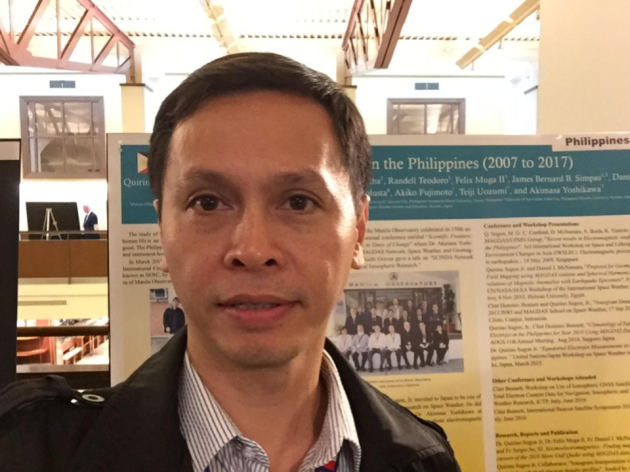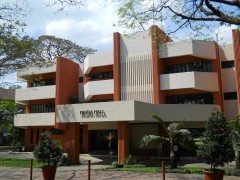Ateneo Physics faculty Clint Bennett attends UN/USA Workshop on International Space Weather Initiative at Boston College
February 2, 2018 Leave a comment

Clint Dominic Bennett of Manila Observatory and Ateneo de Manila University during the poster session of the “UN/USA Workshop on the International Space Weather Initiative: The Decade after the Heliophysical Year 2007” held at Boston College last July 31 to August 2, 2017
Last July 31 to August 2, 2017, Ateneo Physics faculty Clint Dominic Bennett attended The United Nations/United States of America Workshop on the International Space Weather Initiative: The Decade after the International Heliophysical Year 2007, which was organized jointly by the United Nations Office for Outer Space Affairs (UNOOSA), the National Aeronautics and Space Administration (NASA), and Boston College. The workshop was hosted by Boston College in Chestnut Hill, Massachusetts, USA.
ISWI is a “program of international cooperation to advance the space weather science by a combination of instrument deployment, analysis and interpretation of space weather data from the deployed instruments in conjunction with space data, and communicate the results to the public and students. ISWI is a follow-up activity to the successful IHY 2007, but focusing exclusively on space weather.” On the other hand, IHY 2007 is an acronym for the International Heliophysical Year held in 2007, which was held 50 years after the International Geophysical Year (IGY 1957). The aim of International Heliophysical Year (IHY) is to gather scientists and engineers to make a global coordinated observations of the heliosphere to study its effects on the Earth. Just like winds in the the Earth’s atmosphere, the Sun also blows charged particles known as solar wind, creating a bubble called the heliosphere that extends far beyond Pluto until the solar wind is overpowered by the pressure from the hydrogen and helium gas that permeates the Milky Way galaxy: the solar wind then abruptly slows down forming the sheath known as the termination shock.
The ISWI 2017 workshop is divided into 12 topical sessions: (1) International recognition of space weather risks, (2) Building on today’s space weather foundation, (3) Developing an international framework for space weather services, (4) IHY+10: The origins of ISWI, (5) Scientific results on the interplanetary medium and geospace, (6) Scientific results on the ionosphere and thermosphere, (7) Space weather instruments, (8) Space Weather Modeling 1: From Sun to Geospace, (9) Space Weather Modelling 2: Near-Earth Radiation and Plasma Environment, (10) International Outreach and Capacity Building, (11) Coordination of Space- and Ground-Based Data Resources and ISWI, (12) Final Discussion: Observations, Recommendations and the Way Forward.
During the last day of the workshop, representatives from 58 countries presented posters on how their respective countries progressed in ten years after the International Heliophysical Year in 2007. As the representative from the Philippines, Clint presented a poster entitled, Space Weather Activities in the Philippines: 2007-2017, which was co-authored by scientists and researchers from Manila Observatory, Ateneo de Manila University, Ateneo de Davao University, University of San Carlos (Cebu), National Mapping and Resource Information Authority (NAMRIA), and the International Center for Space Weather Science and Education (ICSWSE) of Kyushu University. The poster highlighted several key ISWI-related events in different years, such as the establishment of Kyushu University’s SERC (Space Environment Research Center–now known as ICSWSE) Subcenter at the Ionosphere Research Building of Manila Observatory in 2011, Manila Observatory’s 150th anniversary international conference with space weather presentations by Dr. Keith Groves of Boston College and Dr. Akimasa Yoshikawa of Kyushu University in 2015, the launch of Philippines’ Diwata-I satellite in 2016, and the research fellowship of Dr. Quirino Sugon Jr at Kyushu University in 2016-2017.
Below is an interview with Clint Bennett by Ateneo Physics News:

Clint Dominic Bennett (rightmost) with other participants in the UN/USA ISWI Workshop in Boston College (2017). (Photo credit: ISWI Newsletter)
1. What is your current role at Manila Observatory?
I am currently working with the Upper Atmosphere Dynamics research group of the Manila Observatory. Part of my work is to coordinate the maintenance and transmission of data of the MAGDAS and AMBER magnetometers in the Philippines. I also coordinate with the station managers about their internet connections. I have attended conferences and workshops to keep the group updated and connected with the ISWI community.
2. How were you invited to the conference? Who are the persons you met there?
Originally, Dr. Quirino Sugon, Jr., as ISWI coordinator of the Philippines, was originally invited to attend The United Nations / United States of America Workshop on the International Space Weather Initiative: The Decade after the International Heliophysical Year 2007 which was held last July 31 to August 4, 2017. However, some circumstances prevented him from being able to attend and he asked me to attend on his behalf and in behalf of the ISWI community in the Philippines.
I met a lot of the people the UAD has worked with in the past including Dr. Patricia Doherty, Dr. Endawoke Yizengaw and Dr. Keith Groves of the Institute for Scientific Research in Boston College and Dr. Akimasa Yoshikawa and Dr. Akiko Fujimoto of ICSWSE. Also there were the people who have always played a big role in advancing Space Weather research and keeping the Space Weather community organized and coordinated such as Dr. Nat Gopalswamy of NASA/GSFC and SCOSTEP, Sharafat Gadimova, Co-chair of UNOOSA, Katya Georgieva of SCOSTEP and VarSITI and Terry Onsager of the International Space Environment Service.
3. What was your poster presentation about?
My poster was about the Space Weather Activities in the Philippines for the years 2007 to 2017. In it I reported about the Space Weather Instrument Hosting done by research, academic and government institutions in the Philippines, the international conference organized by the Manila Observatory, the international conference and workshop attendance and presentations from the Philippines, and the space weather research reports and publications from the Philippines.
4. Where did you stay?
For the duration of the workshop, I stayed at Stayer Hall in the Boston College Chestnut Hill campus. Walking around, I met some former Ateneo faculty now working in Boston.
5. How was the weather in Boston College? Did you get to travel around? Any memorable experience?
It was summer time in Boston and the Weather was perfect. In my free time, I traveled around downtown Boston and did my own historical walking tour. As part of the workshop excursion, I was able to go to Boston’s famous Museum of Science were I saw the original Van de Graaff machines made by the American Physicist Robert J. Van de Graaff. After the museum tour, we had the conference banquet just outside the museum by the Charles River. I also got to watch a Major League Baseball game at Fenway park where I enjoyed Fenway franks and conversations with Americans from other walks of life.
6. What important things have you learned at the conference?
This conference was one of the major conferences for the Space Weather community, with over 150 participants from 50 countries. It marked the 10th Anniversary of the International Heliophysical Year, which led to the genesis of the International Space Weather Initiative. It was organized to highlight the achievements of ISWI over the past ten years and to show-case the worldwide development of Space Weather science, capacity building and outreach. Among the important topics were the International Framework for Space Weather Service, International Recognition of Space Weather Risks, Improving Research for Operational Services, Scientific Results on the Interplanetary Medium and Geospace, Scientific Results on the Ionosphere and Thermosphere, Space Weather Instrumentation, Space Weather Modeling, International Outreach and Capacity Building, and Coordination of Space- and Ground-Based Data Resources.
The Conference also included a meeting of the Space Weather community about Observations and Recommendations that will be forwarded to the United Nations and which will be part of the UN’s policies on Space Weather. On the role of a coordinating body to prepare for severe space weather events and mitigate their impacts, presentations and discussions by a wide range of space weather stakeholders, service providers and users illuminated an extensive network of space weather services and capabilities, underpinned by an increased understanding of space weather science, impact and risks. Workshop participants agreed that international coordination was essential to mitigate the threat posed by space weather to the modern interconnected and interdependent society.
On recognizing and building on prior and continuing work by space weather stakeholders, participants recognized that there were many steps that could be taken to develop improved international space weather coordination. The guidelines for the long-term sustainability of outer space activities relating to space weather, namely, sharing operational space weather data and forecasts and developing space weather models and tools and collect established practices on the mitigation of space weather effects, provided the initial basis for examining the implementation of some of the necessary coordination and actions within Member States and their national and international organizations.
And on, UNISPACE+50 and the international framework for space weather services, the participants in the Workshop noted that space weather has a global impact, which necessitates a global response through improved coordination. The Workshop participants agreed that additional coordination was essential at the Member State level, with a view to promoting international coordination and cooperation towards meeting future needs for space weather services. It was noted that UNISPACE+50 represented a unique opportunity to provide input to the Committee on the Peaceful Uses of Outer Space in relation to future requirements for improved space weather services through ISWI. One can read more about UNISPACE+50 at the UNOOSA website.

Group photo during the “UN/USA Workshop on the International Space Weather Initiative: The Decade after the Heliophysical Year 2007” held at Boston College last July 31 to August 2, 2017

